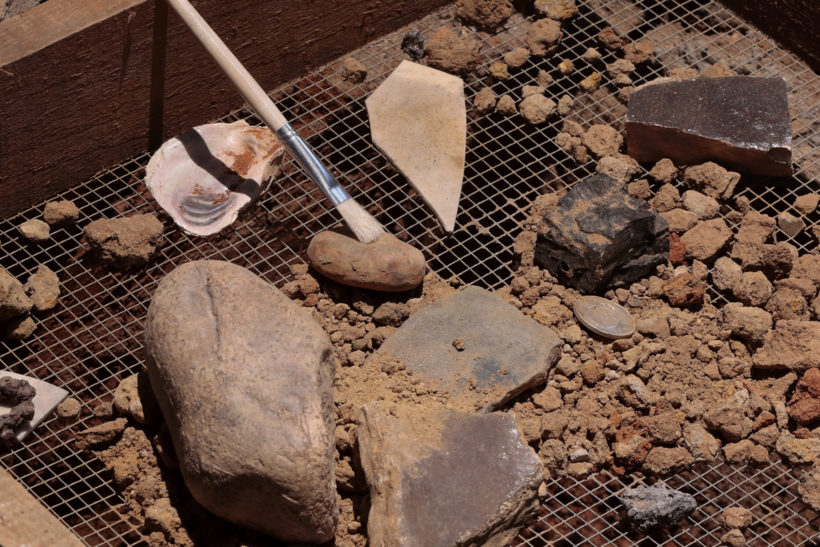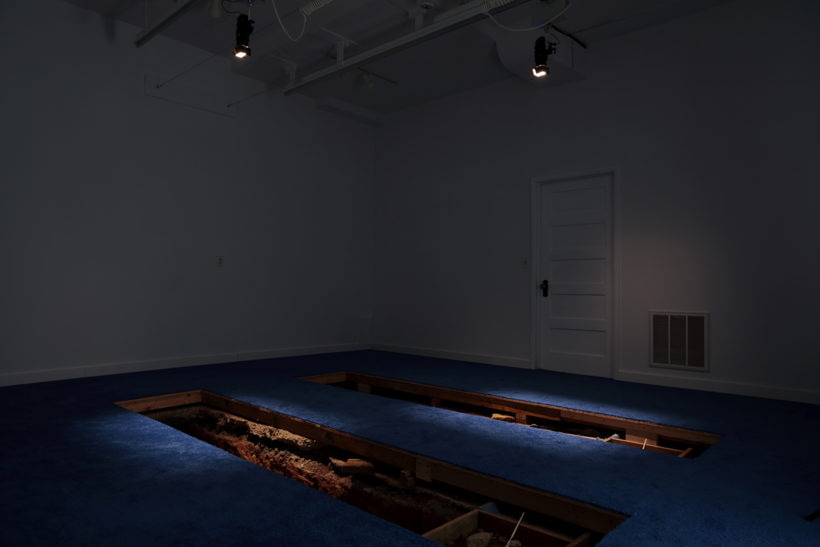
The term sympathetic resonance describes a phenomenon in string instruments: pluck a string of one note, and a string with harmonic likeness vibrates in sympathy. Most directly, strings express this trait when they share the same note but fall on a different octave. A low E makes a high E vibrate, a high D makes a low D vibrate, and so on. These basic rules are easiest to see on an instrument built for making music, but they apply to objects and material of all kinds. A window pane begins to rattle sympathetically when a bass note of a matching frequency vibrates through its material; an entire house can rattle sympathetically with the right frequency and amplitude. The term humanizes these objects and strings, suggesting a romantic, synchronous interiority that gets expressed without direct contact.
Sympathy of this sort is a central framework in Corin Hewitt’s recent exhibition Shadows are to Shade. In the project’s arrangement of architectural constructions, parafictional artifacts, and home houseware objects, resonance is traced not between strings and instruments but rather between two temporally distant owners of a shared piece of land. The sprawling premise of Hewitt’s project starts like this: in 2017, the artist dug four feet through the ground floor of his home studio until he reached the black water pipes beneath his residence. During this dig, the artist uncovered distinct strata of clay that mapped the mid-nineteenth century development of land in the central Richmond neighborhood that his house sits on that, in turn, led him toward the history of the plot of land he occupied.
Hewitt discovered records for the last landowner before the construction of his house, a Teamster named William T. Ford. In 1880, Ford was a forty-eight-year old Richmond City excavator; in 2019, Hewitt is a forty-eight-year old artist excavating the layers of earth and clay beneath his home. Traces of Ford’s subsistence farm mingle with objects of other unattributed origins in the clay below the house, which was originally brought from the James River in order to convert the area’s agrarian landscape into a residential setting.

The exhibition itself is split into two segments: first, a dramatically lit, carpeted presentation of the trenches where this inquiry began at the artist’s home studio, and second, a glowing, scaffolded arrangement of open air domestic “rooms” that fill the double gallery space at the Institute of Contemporary Art in Richmond. At the ICA, two connected gallery spaces become deviant mirror images of each other and function as spaces that resonate without either claiming the position of “origin.” Onstage in each gallery, carpeting and patterned linoleum surfaces underlay dreamlike arrangements illuminated by automated dimming bulbs. Deconstructions of cheap domestic fittings carefully fit into corners of these platforms. In these works, the exposure of particle board material beneath veneered matte black surfaces similarly reads as an excavation, as the interiors of drawers and open medicine cabinets reveal cast extrusions of different clay strata, tan and red each indicating the excavation depth of its corresponding gallery side, and fresh conduit tubing.
Hidden beneath various cabinets, a sculptural motif emerges that depicts an ambiguous process frozen in time: pairs of severed, silicone, white-skinned hands touch a dust filled vac-filter that fits perfectly inside an Instant Pot pressure cooker. Some of the hands appear vibrant and life-like while others are old, dead, and grey. In the larger “rooms,” severed, hollow knees (similarly alive and dead, possibly “chim-knees,” considering their proximity to a large cast fireplace) stand vertically next to plastic buckets. Scattered around other corners are a series of clay and metal coins that depict Hewitt’s own face (2019) and Ford’s face (1880).
An array of modes of presentation occupy these spaces. Carefully arranged rows of original and mimetically cast artifacts appear as archaeological sites that have themselves been frozen in time, breaking down the veracity of this excavation process. Other arrangements show similarly real and fake artifacts still covered in clay and mud, each item almost disappearing under the thin material surfaces that signal this space as domestic or beneath clay. Around the corner, a computer, desk, and chair make up a small home office.
Canonical Fluxus, postminimalist, land art practices come to mind with this work: Joseph Beuys’s arrangements of mystical moments, Eva Hesse’s material-based process artifacts, and Mary Miss’s large-scale trench dig, Perimeters/Pavilions/Decoys (1977-1978). More contemporaneously, artist Brandon Ndife shares Hewitt’s interest in depicting the surface and interior of cheap domestic material. But perhaps most significantly for Hewitt’s practice, Mark Dion’s work of excavating heavily occupied areas such as in Tate Thames Dig (1999) similarly walks a line of fully embracing certain museological practices while playfully disregarding others in order to flatten an archaeological process.

Hewitt is cautious about navigating the politics of centering this inquiry in his work. Ford’s identification as a Teamster places him in a legacy of labor rights, but his involvement in the development of this area becomes inherently linked to the racist property dynamics of the Jim Crow South. The excavation through the ground of his home is premised as a “destabilization” of Hewitt’s property and of his relationship to inherited privileges. Still, some nagging discomfort permeates the space, especially when considering whose histories get remembered.
The premise of this excavation centers subjects defined by their status as property-owners, a status that gets wound up in historically negotiated rights-to-vote along with ownership histories that predate the United States. In this context, stamping each owner’s face on imaginary currency doesn’t really subvert the dominant patterns that determine the race and gender of faces that usually get placed on similar coins. The role of parafiction here remains ambiguous: does it effectively critique the notion that objectivity can exist in historiographic constructions, or does it inject noise into an already delicate ecosystem of information?
When distinguishing between truth and fiction, Bruno Latour is a useful point of reference. The sociologist and philosopher built the early part of his career introducing a critique of the objectivity of the scientific process, pushing against the naïve narratives of heroic experiments that prove or disprove anything concretely. In the last two decades, however, his work has undergone a shift back towards favoring fact, with texts resisting right-wing efforts to weaponize uncertainty as a tool against climate science. Partisan politics have become increasingly relevant when we talk about fact and fiction: in hindsight, Stephen Colbert’s satirical introduction of the word truthiness in 2005 acted as a cue for post-truth politics, an information landscape in which constructed fiction gets passed as fact (a defining condition of parafiction).
There’s a question of what Hewitt’s use of parafictional tactics contributes to his poetic entanglement with Ford, or what they contribute to a political positioning of this land as it has been entangled with the property development of Richmond during and since Reconstruction. Considering these dynamics, truth might be in higher demand right now. This isn’t to say that the sympathetic resonance that occurs between Hewitt and Ford is fundamentally illusory or deceptive. Something about the hauntedness of the two trenches expresses the connections between Hewitt and Ford most fully, in earth that has probably been touched by both of them. That feeling translates into the constructed installation in isolated moments: in the knees/buckets/pipes, in the dreamy domestic deconstructions, and in the formal half-rhymes that make up the Instant Pot sculptures.
Experiencing the two grave-like trenches in the house—where rusting sewage pipes have been partially replaced with clear segments in order to reveal the piss and shit that flushes out of the house and through these excavations—is a somber, touching experience. The sewage that passes through is usually from Hewitt or his family as they go about their lives upstairs; at the museum, it is his family whose knees are cast in hollow, severed forms. In such moments that emphasize the intimacy and proximity in everyday life, Hewitt’s work harnesses individual experience to evoke something more foundational: sympathy as an echo distilled.
Corin Hewitt: Shadows are to Shade is on view at the Institute of Contemporary Art in Richmond, Virginia, through September 1.




